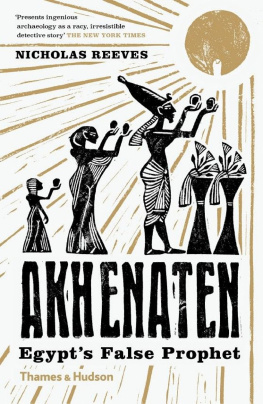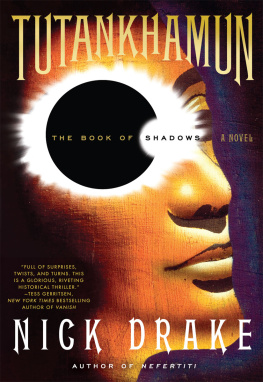AMARNA
SUNSET
AMARNA
SUNSET
Nefertiti, Tutankhamun, Ay, Horemheb,
and the Egyptian Counter-Reformation
Aidan Dodson
The American University in Cairo Press
Cairo New York
First published in 2009 by
The American University in Cairo Press
113 Sharia Kasr el Aini, Cairo, Egypt
420 Fifth Avenue, New York, NY 10018
www.aucpress.com
Copyright 2009 by Aidan Dodson
All rights reserved. No part of this publication may be reproduced, stored in a retrieval system, or transmitted in any form or by any means, electronic, mechanical, photocopying, recording, or otherwise, without the prior written permission of the publisher.
Dar el Kutub No. 4198/09
ISBN 978 977 416 304 3
Dar el Kutub Cataloging-in-Publication Data
Dodson, Aidan
Amarna Sunset: Nefertiti, Tutankhamun, Ay, Horemheb, and the Egyptian Counter-Reformation / Aidan Dodson.Cairo: The American University in Cairo Press, 2009 |
p. cm. |
ISBN 978 977 416 304 3 |
1. Egyptantiquitieskings and rulers I. Title
932 |
1 2 3 4 5 6 7 8 14 13 12 11 10 09
Designed by Andrea El-Akshar
Printed in Egypt
To Dyan: thanks for a wonderful first decade!
CONTENTS
All images are by the author except where otherwise stated.
Maps
Figures


The capital letters indicate the locations of the citys Boundary Stelea that mark out the city limits; a further three stelae were located on the west bank.


Buildings in black are those extant at the end of the reign of Akhenaten, those in dark gray are additions by Horemheb.

| Berlin | gyptisches Museum und Papyrussamlung, Berlin |
| BM | British Museum, London |
| BMA | Brooklyn Museum of Art |
| Cairo | Egyptian Museum, Cairo |
| EA | El-Amarna cuneiform letter (followed by number); for translation see Moran 1992 (cf. p. 148 n.5, below) |
| MFA | Museum of Fine Arts, Boston |
| MMA | Metropolitan Museum of Art, New York |
| o | ostracon (followed by current location/number) |
| OI | Oriental Institute, University of Chicago |
| p | papyrus (followed by current location/number) |
| Petrie | Petrie Museum, University College London |
| RMO | Rijksmuseum van Oudheden, Leiden |
| SCA | Supreme Council of Antiquities |
| TA | Tell el-Amarna tomb |
| TT | Theban Tomb |
| UPMAA | University of Pennsylvania Museum of Archaeology and Anthropology, Philadelphia |
| Vienna | Kunsthistorisches Museum, Vienna |
Where titles of individuals are capitalized, they are more or less direct translations of the original Egyptian. Persons of the same name are distinguished by roman numerals or letters according to a basic system that has developed within Egyptology since the 1970ssee Dodson and Hilton 2004: 39.
I n presenting yet another book on the Amarna Period to the world of Egyptologists, Egyptophiles, and other interested individuals, one feels the degree of trepidation one might otherwise associate with going alone into the zoo tiger-enclosure at feeding time. More so than almost any other era in ancient history, the reigns of Akhenaten and his immediate successors have come to be possessed by a wide variety of individuals, for whom this is something far more than simply a remote period of history. A hint of the widespread usage and abusage of the Amarna Period by people alive in the nineteenth and twentieth centuries AD can be obtained from the lamented Dominic Montserrats superb Akhenaten: History, Fantasy and Ancient Egypt (2000). That book should be compulsory reading for all who consider immersing themselves in the murky waters of Amarna studies.
Part of the problem has been a failure by nonspecialists to appreciate that very little of the Amarna story is indeed fact: much of what we think we know is actually (more or less) inspired guesswork based on what Sir Alan Gardiner so rightly called the rags and tatters that pass for the raw material of ancient Egyptian history writing. As such, scholarly interpretations can change radically overnight with the appearance of new hard evidence. Indeed, readers familiar with my previous published work on the period will doubtless be surprised that some of the key conclusions of the first half of this book are diametrically opposite to ideas I have vigorously propounded and defended over the past three decades. However, my change of views has been a result of the availability of new data, and it is important to be prepared to reconsider ones position, even if it means repudiating long-held beliefs.
Thus, in spite of a century of further research, many nonspecialists remain convinced that the picture put forward by Arthur Weigall in 1910, and other popular works in the following decades, represent the facts of the Amarna Period. Thus Egyptologists who produce new interpretations can run the risk of being accused of such things as slandering the Founder of Monotheism (note capitalization) or of homophobia when pointing out that it now seems Akhenatens gay lover was actually his (female) wife!
It is partly against this background that the present book has been produced, attempting to put forward an up-to-date presentation of the period from the high point of Akhenatens reign through to the assumption of power by the Nineteenth Dynasty four to five decades laterin broad terms the last decades of the fourteenth century BC and the first of the thirteenth century. Treatments of this period have generally been overshadowed by the earlier years of Akhenaten, or distorted by a specific focus on Tutankhamun: my aim is therefore to try to produce a balanced view of these decades. Inevitably there are areas where the view put forward is very much my ownin some ways inevitably, given the lack of real consensus among Amarna Period specialistsbut I have aimed to indicate areas where alternative interpretations exist, and I have made references to them. In this connection, I must point to the work of Marc Gabolde, whose 1998 book is an essential companion for anyone wrestling with the problems of the Akhenaten/Tutankhamun era. As will become clear, I differ widely from him in many areas, yet without his imagination and dogged research some of the key discoveries that have changed the history of the periodin particular the final proof of the true gender of King Neferneferuatenmight not yet have been made. I must thank him for various stimulating discussions and observations over the years.
I have tried to avoid novelty for the sake of it, and where I put forward or support a view that differs from the received wisdomrare as that commodity is in Amarna studiesit is because this is either what seems to produce the most coherent scenario, or what sticks most closely to what the bare evidence suggests. On the other hand, the overall picture put forward inevitably depends on assuming the correctness of certain hypothesesbut with the acknowledgment that they are just that and do not claim to be facts, whatever those might be!
Next page
















